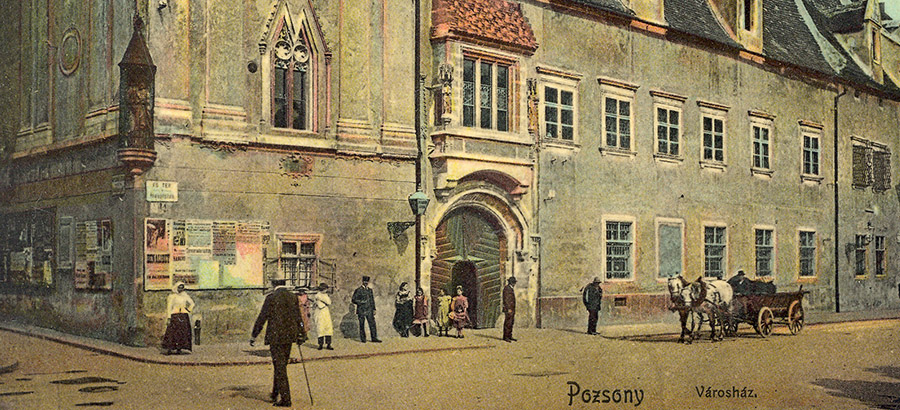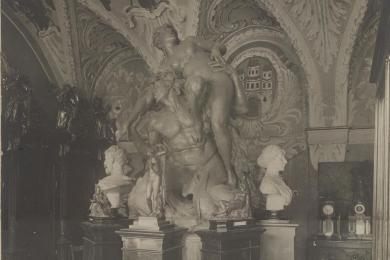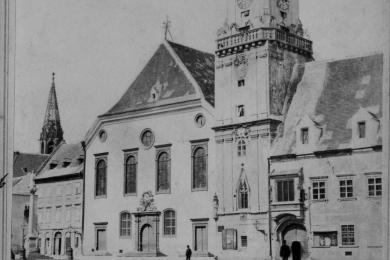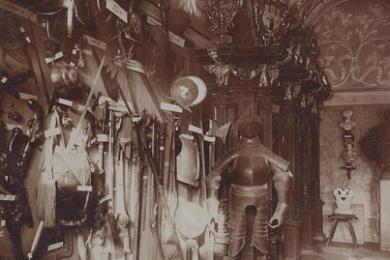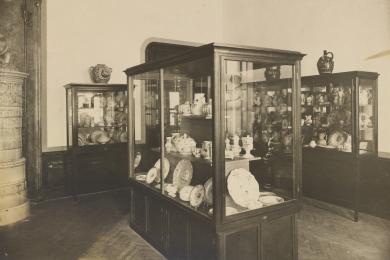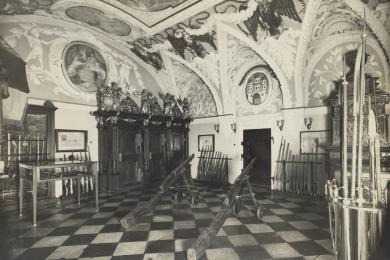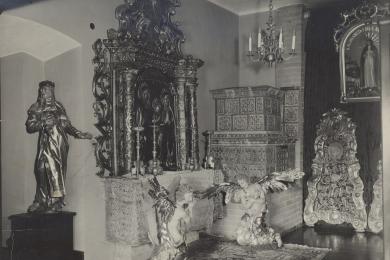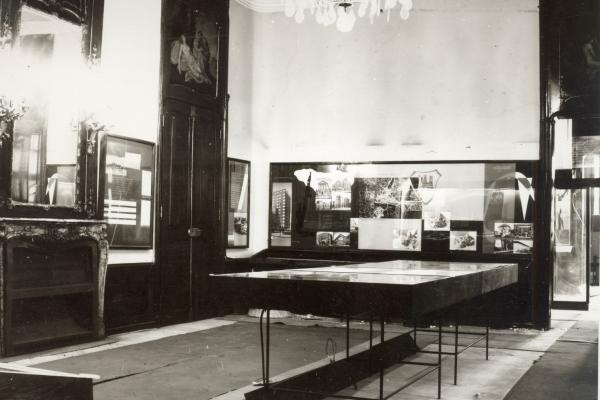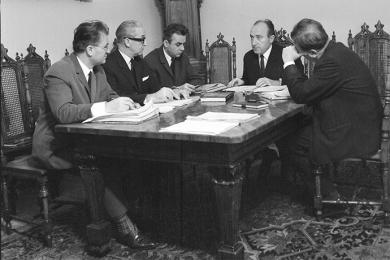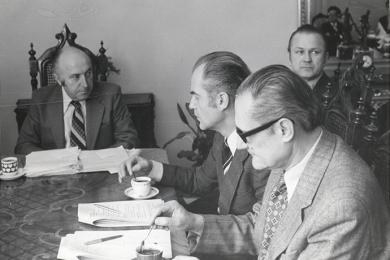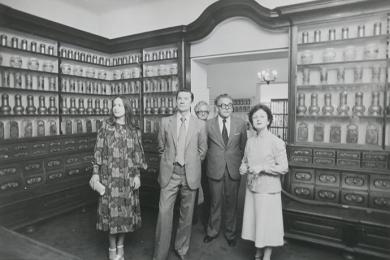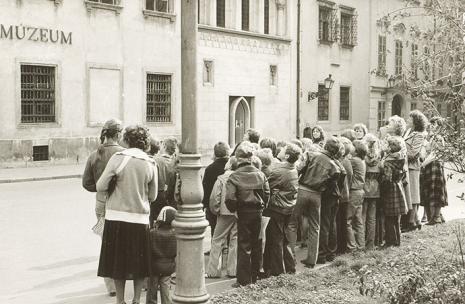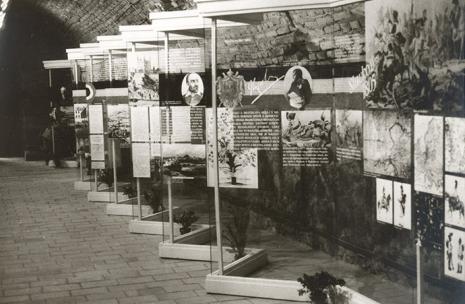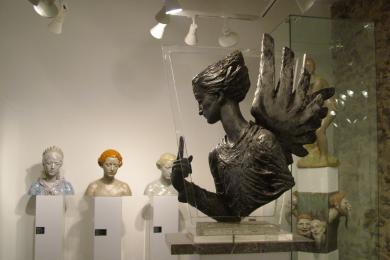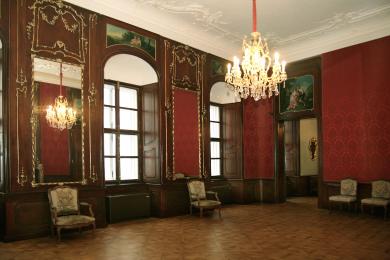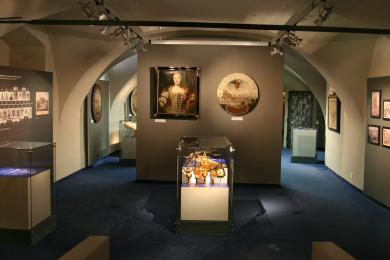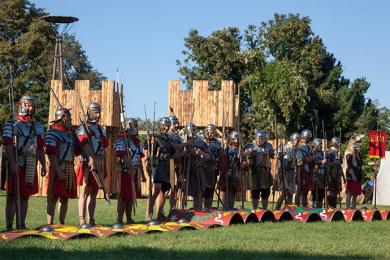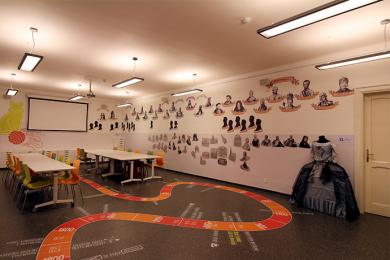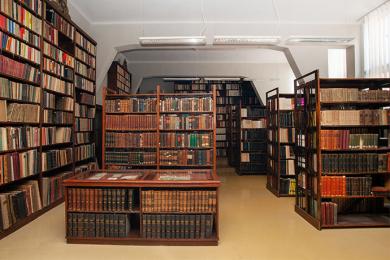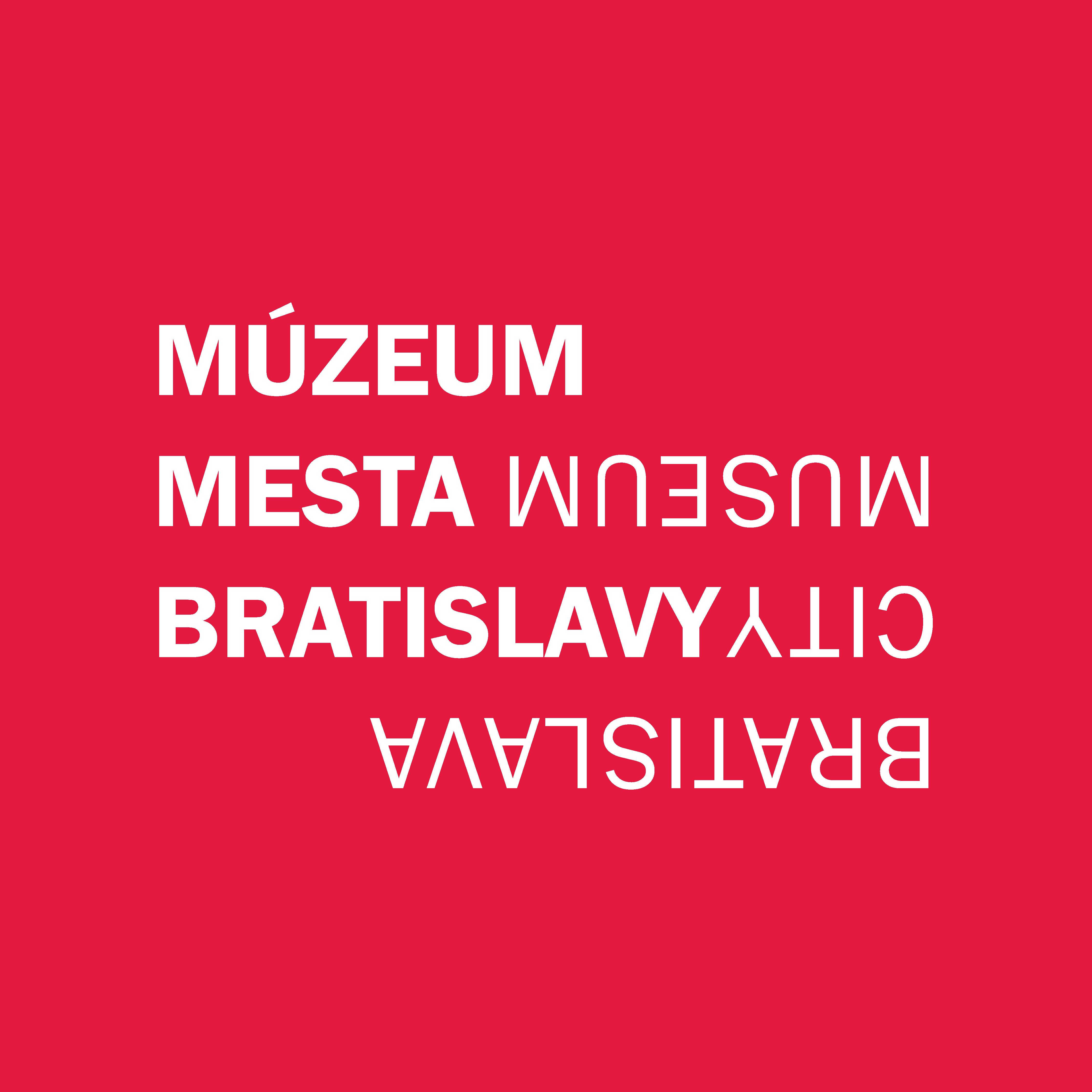1868 – 1918
The Bratislava City Museum was established by the Bratislava (Pressburg) Beautification Society (Pozsonyer Verschönerungsverein). The impetus came at the society‘s session on July 1, 1868 by Jozef Könyöki (1829–1900), grammar school professor. He became the first curator of the Museum holding this office until his death. The birth of the institution was initiated also by other personalities who had outgrown the local setting of the city – especially the pioneer of the archaeological research in Hungary František Floridus Römer (1815–1889), city archivist and organiser of the cultural and social life Ján Nepomuk Batka (1845–1917), as well as the historian Štefan Rakovský (von Rakovszky, 1832–1891), director of the Royal catholic grammar school Karol Polikeit (1849–1921) and city counsellor and police captain František Mottkó (de Mottkó Szent-Kereszt, 1800–1891). A major contribution to the laying of Museum‘s foundations was made by the mayor Henrich Justi (1804–1878) for whom the Museum was an invaluable cultural phenomenon. Thanks to his intervention the Museum was given three the most valuable historical rooms in the Old Town Hall where collections were put on public display as early as October 1869.
The creation of collections started especially thanks to donations by city personalities or significant natives of the city. Valuable collections were acquired, for example, after the end of the Shooting Association, after the disappearance of crafts and donations by the Catholic church. New items were usually divided into four groups: library, archaeology, ethnography and fine arts.
The creation of collections started especially thanks to donations by city personalities or significant natives of the city. Valuable collections were acquired, for example, after the end of the Shooting Association, after the disappearance of crafts and donations by the Catholic church. New items were usually divided into four groups: library, archaeology, ethnography and fine arts.
In 1896, the Museum presented its exhibits for the first time outside Bratislava – the Museum participated in the millennial exposition in Budapest where it was awarded the great bronze medal. At the turn of the 19th and 20th centuries, the work in the Museum started to be professionalized thanks to contemporary curator, professor Augustín Helmár (1847–1912). He focused on ordering of collections and he also created a card catalogue. He was succeeded in 1904 by professor Ján Ev. Albrecht (1852–1925) who stayed in the Museum until 1919. During his times in 1911, the first official concept of collecting programme for art collections was published.
At the beginning of the 20th century, the location of the Museum in the Old Town Hall was still considered provisional. It was to move to modern locations in a new building planned to be built on what used to be called Justi embankment. However, this plan was never to be carried out. The outbreak of the WWI had a negative impact on the Museum‘s activities as the culture was marginalised – both by the city and the state. The dissolution of the Austria-Hungary and the inclusion of the city into Czechoslovakia raised the need to search for the new identity of the Museum.
Interwar period
The Museum, sponsored by the Association until then, got under the governance of the mayor‘s office and received a regular funding from the city‘s budget. A fundamental change was introduced also in terms of the personnel – the Museum hired university educated curators: Gizela Leweke-Weydeová (1894–1984), Oľga Wagnerová (1902–1976), later on also Alžbeta Mayerová, née Güntherová (1905– 1973), one of the pioneer personalities of Slovak fine-art history and museology. Specialised education and orientation of this three curators were soon reflected in the deepening of historical and especially art-historical profile of the Museum.
Ovídius Faust put forward a proposal of a fundamental reorganisation of the institution and its modification into a Museum focusing on economic, political and cultural life, architectural development of the city, development of the education, industry and public life.
Revival of acquisition activities began only after 1923. Thanks to the financial support of the city as well as of the state in the mid-1920s, the Museum had more possibilities to enlarge its collections. Besides purchasing from private owners, more and more items were acquired from antique shops. The Museum‘s management and curators were doing their best to make a more rigorous selection of items and a more pronounced focus on the city of Bratislava. Already in the mid-1920s the attention was paid also to the contemporary fine art scene and to modern applied arts.
In the 1930s, in addition to enlarging and expanding of existing groups in the collection (fine arts, applied arts, craft memorabilia, numismatics) an interest in other groups appeared (pharmacy, theatre set designs). More attention was shifted towards ethnographic items. A. Güntherová and O. Wagnerová carried out the first professional treatment of rich Museum collections. Their work culminated in publishing the Catalogue of the Bratislava City Museum (Katalog Muzea mesta Bratislavy) in 1933, still used by specialists.
The first public display of Museum’s collections in the inter-war period was organised in 1926 in the rooms on the first floor of the Apponyi House. Next year, the Museum opened state rooms of the Old Town Hall for the public and a year later also another room, the so-called Gemeindestube, which housed a rich display of arms. The year 1930 saw a significant milestone – opening of a picture gallery on the second floor of the Apponyi House. The first gallery exhibition in the history of the city included the works of old as well as contemporary masters (more than 300 exhibits), complete with applied arts items. In 1931, the Museum established a “torture chamber” in the tower of the Old Town Hall with original and renovated items and in a room entitled „astronomy department“ were displayed clocks, globes, various astronomical and scientific instruments and historical maps. In 1932, also “church hall” with more than 100 exhibits was added to the rooms opened for public.
Within the second exhibition tour, the Museum offered the reinstalled historical collections and newly displayed archaeological collections (prehistoric and Roman finds) in the rooms of the Old Town Hall. In 1932, the Bratislava Wine Museum was established and opened on the ground floor of the Apponyi House.
The process of displaying collection items was finished in 1937 on the ground floor of the Old Town Hall by exhibiting a complete ethnographic collection donated by František Kraus (more than 200 items), deputy mayor of the city of Bratislava. The same year saw the opening of a small museum to commemorate the 100th anniversary of the death of the composer J. N. Hummel (1778–1837) in two rooms of a house on the Klobučnícka ulica, then passed for his birthplace.
1939–1945
After the creation of the 1st Slovak Republic, the Museum remained within the Scientific institutes of the city of Bratislava. The society started to be affected by the German propaganda that led to strengthening of national spirit and patriotic education.
Museum‘s acquisition and collecting activities were focused on fine art works of Slovak artists depicting also scenes from the distant past of Slovaks and its orientation was burdened with new state nationalistic ideology emphasizing “eternal Slovak-German friendship”. However, existent Museum‘s exhibitions remained untouched and displays did not reflect new political reality in that period.
1946 - 1960
Though official documents of the National Committee called for participation in the socialist two-year building programme (1947–1948), in the particular circumstances of the Museum it corresponded to staff screening, gradual adjustment of employment conditions and the emphasis given to the “elaboration” of the idea of Slavism as a defence against Germanism. In the acquisition activities, the dominant trend of acquiring artistic items persisted, yet building of collections in this era followed a declining trend.
After the “victorious February of the working people”, the National Committee expressed its dissatisfaction with the ideological content of the Museum’s existing exhibition. It was the failure to live up to their expectations that was probably behind removing J. Kálmán from the Museum’s management in 1951. The post of the Museum’s management and the the history department was taken over by Alojz Mayer (1920–1993) who stayed the head of the Museum until 1958.
In the years 1953–1955, the Scientific Institutes successively disappeared – the city archive was attached to the Interior Department, the Museum with the scientific and technical library remained under the Department of Culture of the Central National Committee in Bratislava.
The state’s cultural policy was changing to become a tool of re-education of citizens and promotion of political goals of the Communist Party of Czechoslovakia. Museums were supposed to contribute to the building of socialism, to document socialist progress and to form a new Soviet person. The focus of the Museums' campaigning and promotional activities was implemented through departments and exhibitions of the building of socialism and regular commemoration of communist holidays (the anniversary of the Great October Socialist Revolution, the foundation of the Communist Party of Czechoslovakia, liberation, the anniversary of the Slovak National Uprising, the Victorious February and others).
Since 1950, a new historic exhibition in 16 rooms in the Old Town Hall building complex and the neighbouring Apponyi House, was installed step by step. The newly created exhibition was the first attempt to present the history of Bratislava from the earliest settlement up to the contemporary period. In addition to the above-mentioned exhibition rooms, the Museum had at its disposal an exhibition hall on the first floor of the Mirbach Palace in the years 1952–1955, and since 1953, the state rooms of the Primate’s Palace, where a gallery exhibition was installed, as well. In 1954, the J. N. Hummel Memorial House underwent re-installation.
The organisation structure of the City Museum was expanded to include two museums – specialised exhibitions – as its new branches, in the years 1957 and 1958: Janko Jesenský Museum, originally managed by the Slovak Museum, and the Pharmacy Museum, which was supposed to have nationwide scope. The renovation of the memorial house of the Slovak Communist Party’s illegal activity at Priekopy 73, carried out during 1956–1959, and the opening of an exhibition in 1960 already marked the beginning of a new trend in the Museum’s activities – making memorial sites open to the public. It was also consistent with the idea to document the communist movement and with Czechoslovakia’s cultural and political orientation.
New ideas about museology work focusing on national ethnography, history and geography materialized in the establishment of the City Institute covering these areas on January 1, 1959. It was founded as a cultural and awareness-raising establishment for promoting, documenting and studying the evolution of society and nature with territorial competence of the City National Committee in Bratislava. The institute consisted of the City Museum, City Gallery, Monuments Centre, Regional Library and an economic and administrative service. The role of the City Museum was to collect, store, scientifically treat and display items documenting the evolution of nature and society related to the Great Bratislava territory, as well as Bratislava city, and it was made equivalent to a regional museum.
ince 1950, a new historic exhibition in 16 rooms in the Old Town Hall building complex and the neighbouring Apponyi House, was installed step by step. The newly created exhibition was the first attempt to present the history of Bratislava from the earliest settlement up to the contemporary period. In addition to the above-mentioned exhibition rooms, the Museum had at its disposal an exhibition hall on the first floor of the Mirbach Palace in the years 1952–1955, and since 1953, the state rooms of the Primate’s Palace, where a gallery exhibition was installed, as well. In 1954, the J. N. Hummel Memorial House underwent re-installation. The organisation structure of the City Museum was expanded to include two museums – specialised exhibitions – as its new branches, in the years 1957 and 1958: Janko Jesenský Museum, originally managed by the Slovak Museum, and the Pharmacy Museum, which was supposed to have nationwide scope. The renovation of the memorial house of the Slovak Communist Party’s illegal activity at Priekopy 73, carried out during 1956–1959, and the opening of an exhibition in 1960 already marked the beginning of a new trend in the Museum’s activities – making memorial sites open to the public. It was also consistent with the idea to document the communist movement and with Czechoslovakia’s cultural and political orientation.
New ideas about museology work focusing on national ethnography, history and geography materialized in the establishment of the City Institute covering these areas on January 1, 1959. It was founded as a cultural and awareness-raising establishment for promoting, documenting and studying the evolution of society and nature with territorial competence of the City National Committee in Bratislava. The institute consisted of the City Museum, City Gallery, Monuments Centre, Regional Library and an economic and administrative service. The role of the City Museum was to collect, store, scientifically treat and display items documenting the evolution of nature and society related to the Great Bratislava territory, as well as Bratislava city, and it was made equivalent to a regional museum.
Since 1950, a new historic exhibition in 16 rooms in the Old Town Hall building complex and the neighbouring Apponyi House, was installed step by step. The newly created exhibition was the first attempt to present the history of Bratislava from the earliest settlement up to the contemporary period. In addition to the above-mentioned exhibition rooms, the Museum had at its disposal an exhibition hall on the first floor of the Mirbach Palace in the years 1952–1955, and since 1953, the state rooms of the Primate’s Palace, where a gallery exhibition was installed, as well. In 1954, the J. N. Hummel Memorial House underwent re-installation. The organisation structure of the City Museum was expanded to include two museums – specialised exhibitions – as its new branches, in the years 1957 and 1958: Janko Jesenský Museum, originally managed by the Slovak Museum, and the Pharmacy Museum, which was supposed to have nationwide scope. The renovation of the memorial house of the Slovak Communist Party’s illegal activity at Priekopy 73, carried out during 1956–1959, and the opening of an exhibition in 1960 already marked the beginning of a new trend in the Museum’s activities – making memorial sites open to the public. It was also consistent with the idea to document the communist movement and with Czechoslovakia’s cultural and political orientation.
New ideas about museology work focusing on national ethnography, history and geography materialized in the establishment of the City Institute covering these areas on January 1, 1959. It was founded as a cultural and awareness-raising establishment for promoting, documenting and studying the evolution of society and nature with territorial competence of the City National Committee in Bratislava. The institute consisted of the City Museum, City Gallery, Monuments Centre, Regional Library and an economic and administrative service. The role of the City Museum was to collect, store, scientifically treat and display items documenting the evolution of nature and society related to the Great Bratislava territory, as well as Bratislava city, and it was made equivalent to a regional museum.
1961 - 1989
Na základe múzejného zákona nadobudla inštitúcia význam aj ako špecializované osvetové, neskôr kultúrnovýchovné zariadenie Mestského národného výboru. Múzeum sa stalo významnou súčasťou prezentácie mesta a z tohto dôvodu boli jeho aktivity zriaďovateľom aj patrične podporované.
Za najvýznamnejšie prezentačné aktivity sa považovali expozície, ktoré mali byť najdôležitejším prostriedkom politicko-výchovnej práce. Túto etapu múzeum začínalo s jednou expozíciou zameranou na dejiny mesta a vtedy ešte pobočkami, ktorými boli Múzeum Janka Jesenského, Múzeum farmácie, Pamätná izba J. N. Hummela a Pamätný domček ilegálnej činnosti KSS za okupácie. Postupne pribúdali ďalšie expozície a tie pôvodné prechádzali reinštaláciami. Realizácia týchto aktivít bola vždy spojená aj s rekonštrukciami objektov, novými akvizíciami, vedeckovýskumnou činnosťou. V tomto období sa podarilo pripraviť a sprístupniť 12 expozícií (expozícia dejín mesta, feudálnej justície, vinohradníctva a vinárstva, rodný dom J. N. Hummela, Janka Jesenského, farmácie, domček ilegálnej činnosti Komunistickej strany počas okupácie, zbraní a mestského opevnenia, Vajnorský ľudový dom, hodín, umeleckého remesla, expozícia antiky v Rusovciach), z ktorých podstatná časť je po reinštaláciách prístupná aj v súčasnosti. Mestské múzeum sa výraznou mierou podieľalo aj na tvorbe a realizácii expozície Izba revolučných tradícií v Dúbravke.
Múzeum pokračovalo v riešení úloh súvisiacich s pamiatkovou starostlivosťou. Začiatkom 60. rokov ukončilo investorskú činnosť na rekonštrukcii Bratislavského hradu, ktorá prebiehala od roku 1954. V roku 1964 začali práce na generálnej oprave Starej radnice. Postupne múzeum realizovalo pamiatkovú obnovu ďalších objektov pre svoje expozície. Realizovalo tiež rozsiahlu rekonštrukcia hradu Devín. Okrem toho v 60. rokoch 20. storočia vykonávalo aj ochranu prírody a správu verejných pamätníkov.
Dôležitou zložkou činnosti múzea sa stal terénny výskum. V 60. rokoch sa začal vykonávať systematický archeologický výskum, predovšetkým v Devíne (v areáli hradu, aj v obci). V polovici 80. rokov múzeum začalo realizovať archeologické výskumy v Rusovciach. Národopisný výskum sa zameral na niekdajšie priľahlé obce – dnes súčasti Bratislavy (Vajnory, Lamač, Záhorská Bystrica, Dúbravka).
Oficiálna akvizičná politika múzea vychádzala z dobovej tendencie dokumentácie života pracujúceho ľudu. V skutočnosti sa však zbierkové fondy rozširovali najmä o predmety dokladajúce život v meste bez ohľadu na sociálnu či politickú príslušnosť jeho obyvateľov. Artefakty nadobudnuté v zmysle deklarovaného zamerania tvorili iba zanedbateľnú časť z celkového počtu nadobudnutých artefaktov. Akvizície v 70. rokov 20. storočia patria k najpočetnejším v histórii múzea. Ročne sa jeho zbierky rozrastali priemerne o 2 000 predmetov.
70. roky a 80. roky sa v dejinách inštitúcie spájajú s veľkým rozmachom v oblasti prezentačnej činnosti. Okrem expozícií to bola bohatá výstavná činnosť a múzeum sa intenzívnejšie prezentovalo aj v zahraničí. Veľká pozornosť bola zameraná aj na kultúrno-výchovnú činnosť pre mládež i širokú verejnosť a spoluprácu s rôznymi kultúrnymi i spoločenskými organizáciami.
V súvislosti s prípravou nových expozícií sa systematickejšia pozornosť venovala konzervovaniu a reštaurovaniu zbierkových predmetov. Múzeu sa postupne podarilo vybudovať vlastné reštaurátorské dielne. Súbežne prebiehalo aj externé reštaurovanie v spolupráci s viacerými vtedajšími významnými reštaurátorskými pracoviskami.
Od roku 1965 začalo múzeum vydávať vlastný zborník – ročenku Bratislava, s podtitulom Spisy Mestského múzea (Acta Musei Civitatis Bratislavensis), ktorá sa stala významným periodikom, poskytujúcim priestor na publikovanie fundovaných vedeckých a odborných štúdií zásadného významu týkajúcich sa histórie Bratislavy.
The Museum after 1990
Following the initial slowdown caused by the lack of funding, the Museum pursued its regular acquisition of collections. Besides finds from archaeological research, items were steadily acquired by means of donations every year. The current profile of the collection is based on its primary segmentation established back in the years 1961–1984. In the last decades, the Museum acquired a number of artefacts documenting different standards of living in the city, primarily sets of objects from the properties of Bratislava families with an emphasis on documenting the second half of the 20th century.
Creation of new exhibitions represents a significant project activity of the Museum. In 2002, the Arthur Fleischmann Museum exhibition was established, presenting the life and works of the Bratislava born and internationally renowned sculptor. After the completion of the Apponyi House restoration in 2008, two new exhibitions opened in its premises: Wine Museum and Period Rooms Museum. After completing the restoration of the Old Town Hall building complex, the Museum of the City History exhibition was opened to the public.
Významným projektom múzea je tvorba nových expozícií. V roku 2002 vznikla expozícia Múzeum Arthura Fleischmanna prezentujúca život a dielo bratislavského rodáka a medzinárodne uznávaného sochára. V roku 2008 po ukončení rekonštrukcie Apponyiho paláca sa v jeho priestoroch otvorili dve nové expozície: Múzeum vinohradníctva a Múzeum historických interiérov. Po ukončení rekonštrukcie komplexu budov Starej radnice bola sprístupnená expozícia Múzeum dejín mesta.
A number of publicly attractive exhibitions took place in the Museum’s exhibition rooms in the Old Town Hall and in the national cultural monument of the Devín Castle – in-house ones as well as exhibitions prepared in cooperation with other institutions such as the Slovak National Gallery, the City Gallery of Bratislava or the Bratislava City Archives. During the 1990s, the Museum successfully presented itself abroad with several exhibition projects. By loaning its exhibits, the Museum also participated in numerous exhibitions organised by other institutions at home and abroad. Among the most significant ones was the Crown of Bohemia exhibition installed in the New York Metropolitan Museum of Art (2005), in Prague in 2006 under the name Charles IV The Emperor by the Grace of God or Sigismundu, and Rex et Imperator in the Luxembourg National Museum (2006). The institution got also involved in international projects in the field of archaeology, for example in the Frontiers of the Roman Empire (FRE) project under the Culture 2000 European Union programme.
The Museum keeps becoming better known to the public through a wide range of cultural events. Since 1999, this has been, in particular, the Roman Games held annually in the Ancient Gerulata Museum in Rusovce. The year 2008 saw the foundation of the Museum Is Alive! project, created to promote knowledge acquisition and to popularise the history of Bratislava. It represents a summary of programmes for non-formal education and training of children and adults, it introduces interactive events focusing not only on education in the field of history, but also on skills development and on building the critical historical awareness in children and adolescents. In restored premises of the Old Town Hall, the Museum Has a Future children’s studio, which prepares attractive projects of leisure activities describing the region’s history every year, was launched in 2011.
The Museum has extended its publishing activities as well. After a 22-year break, the publication of the Museum’s yearbook was renewed in 1998, under the name Bratislava. The City Museum Yearbook, or rather Bratislava. Bratislava City Museum Yearbook after the institution’s name change. In recent years, the publication of printed guides to in-house exhibitions and proceedings from conferences organised by the museum has become a tradition. Equally successful is The Textbooks Come Alive edition for youth education programmes.
A specialised library that was probably established right after the Museum’s foundation in 1868, is also a part of the Museum. The museological and academic literature or books relating to the city history, the so-called posoniensia, from the local book printers and publishers, represent a significant part of the fund.
In 2018, the Museum celebrated its 150th anniversary. Besides the exhibition dedicated to the Museum’s history and several activities presenting its activities, it managed to publish a scientific monograph entitled In the Vortex of History, mapping meticulously the institution’s establishment, development and activities.

